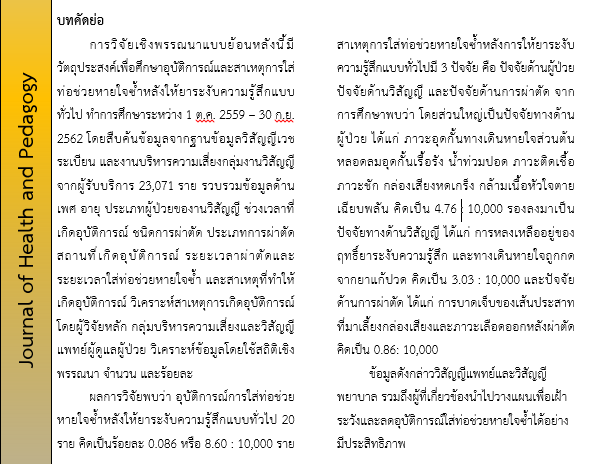อุบัติการณ์และสาเหตุการใส่ท่อช่วยหายใจซ้ำหลังการให้ยาระงับความรู้สึกแบบทั่วไปในโรงพยาบาลสงขลา
คำสำคัญ:
การใส่ท่อช่วยหายใจซ้ำ, การให้ยาระงับความรู้สึกทั่วไป, อุบัติการณ์บทคัดย่อ
ก
การวิจัยเชิงพรรณนาแบบย้อนหลังนี้มีวัตถุประสงค์เพื่อศึกษาอุบัติการณ์และสาเหตุการใส่ท่อช่วยหายใจซ้ำหลังให้ยาระงับความรู้สึกแบบทั่วไป ทำการศึกษาระหว่าง 1 ต.ค. 2559 – 30 ก.ย. 2562 โดยสืบค้นข้อมูลจากฐานข้อมูลวิสัญญีเวชระเบียน และงานบริหารความเสี่ยงกลุ่มงานวิสัญญี จากผู้รับบริการ 23,071 ราย รวบรวมข้อมูลด้านเพศ อายุ ประเภทผู้ป่วยของานวิสัญญี ช่วงเวลาที่เกิดอุบัติการณ์ ชนิดการผ่าตัด ประเภทการผ่าตัด สถานที่เกิดอุบัติการณ์ ระยะเวลาผ่าตัดและระยะเวลาใส่ท่อช่วยหายใจซ้ำ และสาเหตุที่ทำให้เกิดอุบัติการณ์ วิเคราะห์สาเหตุการเกิดอุบัติการณ์โดยผู้วิจัยหลัก กลุ่มบริหารความเสี่ยงและวิสัญญีแพทย์ผู้ดูแลผู้ป่วย วิเคราะห์ข้อมูลโดยใช้สถิติเชิงพรรณนา จำนวน และร้อยละ
ผลการวิจัยพบว่า อุบัติการณ์การใส่ท่อช่วยหายใจซ้ำหลังให้ยาระงับความรู้สึกแบบทั่วไป 20 ราย คิดเป็นร้อยละ 0.086 หรือ 8.60 : 10,000 ราย สาเหตุการใส่ท่อช่วยหายใจซ้ำหลังการให้ยาระงับความรู้สึกแบบทั่วไปมี 3 ปัจจัย คือ ปัจจัยด้านผู้ป่วย ปัจจัยด้านวิสัญญี และปัจจัยด้านการผ่าตัด จากการศึกษาพบว่า โดยส่วนใหญ่เป็นปัจจัยทางด้านผู้ป่วย ได้แก่ ภาวะอุดกั้นทางเดินหายใจส่วนต้น หลอดลมอุดกั้นเรื้อรัง น้ำท่วมปอด ภาวะติดเชื้อ ภาวะชัก กล่องเสียงหดเกร็ง กล้ามเนื้อหัวใจตายเฉียบพลัน คิดเป็น 4.76 : 10,000 รองลงมาเป็นปัจจัยทางด้านวิสัญญี ได้แก่ การหลงเหลืออยู่ของฤทธิ์ยาระงับความรู้สึก และทางเดินหายใจถูกกดจากยาแก้ปวด คิดเป็น 3.03 : 10,000 และปัจจัยด้านการผ่าตัด ได้แก่ การบาดเจ็บของเส้นประสาทที่มาเลี้ยงกล่องเสียงและภาวะเลือดออกหลังผ่าตัด คิดเป็น 0.86: 10,000
ข้อมูลดังกล่าววิสัญญีแพทย์และวิสัญญีพยาบาล รวมถึงผู้ที่เกี่ยวข้องนำไปวางแผนเพื่อเฝ้าระวังและลดอุบัติการณ์ใส่ท่อช่วยหายใจซ้ำได้อย่างมีประสิทธิภาพ
เอกสารอ้างอิง
Bunchungmongkol, N., Pipanmekaporn, T., Punjaswadwong, Y. & Cenpakdee, S. (2009). Reintubation in the
postanesthesia care unit: A retrospective study of 21,349 cases at Chiang Mai University Hospital, Thailand.
Chiang Mai med Journal, 48(2), 49-55.
Charuluxananan, S., Punjasawadwong, Y., Pitimana-aree, S., Werawatganon, T., Lekprasert, V., Nimmaanrat, S., et al.
(2017). Multicentered study of anesthesia: related mortality and adverse events by incident reports in Thailand.
Health Systems Research Institute, Research Report. Retrieved December 1, 2019 from
http://www.hsri.or.th/research. (in Thai)
Chien, CL., Hsun, CS., Sheng HL, Cheng, YL. (2015). Postoperative Reintubation at Postanesthesia Care Unit from 2010
to 2011 at a Teaching Hospital in Taiwan. E-Da Med J., 2(38-42).
Chinachoti, T., Chau-in, W., Suraseranivongse, S., Kitsampanwong, W., & Kongrit, P. (2005). Postoperative
reintubation after planned extubation in Thai Anesthesia incident Study (THAI Study). J Med Assoc Thai, 88(7),
-94.
Cholitkul, S. (2012). A retrospective study The Incidence of Rrintubation after General Anesthesia at Chiangrai
Prachanukroh Hospital. Chiangrai Medical Journal, 4(1), 41-48.
Department of Anesthesioloy, Songkhla Hospital. (2020). Risk Management in Anesthesia (2017-2019). Songkhla.
(in Thai)
Duangngoen, P., Ittichaikulthol, W., Thamjamrassri, T., & Jiarpinitnun, J. (2016). Risk factor of reintubation in post
anesthetic care unit after general anesthesia in Ramathibodi Hospital. Thai journal of Anesthesiology, 42(1), 33-
Junkao, J. (2011). An Incidence Study of Risk Factors Related to Re-intubations in the Post-Anesthetic Care Unit,
Lampang Hospital. Boromarajonnani College of Nursing, Uttaradit Journal, 3(2), 12-18.
Kongsayreepong, S. (2002). Anatomy and Physiology in Neonatal and Pediatric. In Kongsayreepong, S. &
Suraseranivong, S. Anesthesia in Infancy and Childhood. (pp. 1-46). Bangkok: Ruenkaew Printing. (in Thai)
Luetrakool, P. (2015). Anesthesia in Thyroid. In Pulnitiporn, A., Raksakietisak, M., Charoenraj, P., & Ruananukun, N.
Anesthesiology. (pp. 365-374). The Royal College of Anesthesiologists of Thailand. (in Thai)
Pansamai, L. (2011). Reintubation during Anesthesia in Saraburi Hospital. KM Siriraj. Retrieved November 12, 2019
from: http://www1.si.mahidol. ac.th/km/sites/default/files/95.pdf. (in Thai)
Pinsornsak, B. (2008). Incidence, Causes and Complications of Reintubation after General Anesthesia in the Recovery
Room, Phranakhonsriayutthaya hospital. Region 4 medical journal, 10(6), 1091-1096.
Rajinda, K. (2007). The Incidence of Reintubation in OR and PACU Following General Anesthesia with Endotracheal
Intubation at Sappasittiprasong Hospital. Khon Kaen Medical Journal, 31(1), 73-78.
Raksakietisak, M. (2015). Anesthesia for The Elderly. In Pulnitiporn, A., Raksakietisak, M., Charoenraj, P., &
Ruananukun, N. Anesthesiology. (pp. 207-214). The Royal College of Anesthesiologists of Thailand. (in Thai)
Rodanant, O. (2015). Postanesthetic Care. In Pulnitiporn, A., Raksakietisak, M., Charoenraj, P., & Ruananukun, N.
Anesthesiology. (pp. 399-409). The Royal College of Anesthesiologists of Thailand. (in Thai)
Rujirojindakul, P., Geater, A.F., Mc Neil, E.B., Vasinanukorn, P., Prathep, S., Asim, W., et al. (2012). Risk factors for
reintubation in the post-anesthetic care unit: a case-control study. Br J Anaesth, 109(4), 636-642.
The Royal College of Anesthesiologists of Thailand. (2019). Guidance for Anesthesia Record Form Retrieved May 3,
from: http://anesthai.org/ public/rcat/Document. (in Thai)
Uppan, K., Jeerararuensak, W., Chau-In, W., Chairatana, L., Promkhote, p. (2011). Anesthesia Related to Reintubation
after Planned Extubation within 24 Hours after General Anesthesia in Srinagarind Hospital: Incidence and Risk
Factors. Srinagarind Med Journal, 26(4), 325-332.
Watcharotayangul, J., Virankabutra, T., Supathada, P., Prueksawisatesuk, W. (2020). Cuff leak test predicting upper
airway obstruction and reintubation after extubation. Medicine Facaulty Rhamatibodee. Retrieved June10, 2020
from: http://Rama.Mahidol.ac.th/anest/sites/default/files/public/pdf. (in Thai)

ดาวน์โหลด
เผยแพร่แล้ว
เวอร์ชัน
- 2022-12-23 (2)
- 2022-02-07 (1)
รูปแบบการอ้างอิง
ฉบับ
ประเภทบทความ
สัญญาอนุญาต
ลิขสิทธิ์ (c) 2022 วิทยาลัยพยาบาลบรมราชชนนี นครศรีธรรมราช

อนุญาตภายใต้เงื่อนไข Creative Commons Attribution-NonCommercial-NoDerivatives 4.0 International License.
บทความที่ได้รับการตีพิมพ์เป็นลิขสิทธิ์ของ วิทยาลัยพยาบาลบรมราชชนนี นครศรีธรรมราช
ข้อความที่ปรากฏในบทความแต่ละเรื่องในวารสารวิชาการเล่มนี้เป็นความคิดเห็นส่วนตัวของผู้เขียนแต่ละท่านไม่เกี่ยวข้องกับวิทยาลัยพยาบาลบรมราชชนนี นครศรีธรรมราช และบุคคลากรท่านอื่น ๆ ในวิทยาลัยฯ แต่อย่างใด ความรับผิดชอบองค์ประกอบทั้งหมดของบทความแต่ละเรื่องเป็นของผู้เขียนแต่ละท่าน หากมีความผิดพลาดใดๆ ผู้เขียนแต่ละท่านจะรับผิดชอบบทความของตนเองแต่ผู้เดียว




